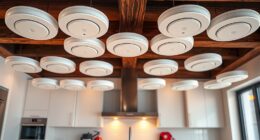Exploring the realm of cochlear implants is akin to embarking on a journey through a diverse landscape of hearing options, each tailored to address individual hearing requirements.
From Bone Conduction Implants offering remedies for outer or middle ear sound conduction issues to the intricate workings of Auditory Brainstem Implants for nerve function complexities, the array of options can seem overwhelming at first glance.
Yet, understanding the nuances of each implant type is crucial for making informed decisions that impact our hearing abilities profoundly.
Key Takeaways
- Cochlear implants offer various options like BTE, bone conduction, middle ear, and auditory brainstem for diverse hearing needs.
- Each implant type serves specific conditions, addressing outer, middle, or nerve-related issues effectively.
- Selection depends on individual requirements, balancing performance, comfort, and practicality in daily use.
- Consulting with audiologists is crucial to determine the most suitable cochlear implant type for optimal hearing outcomes.
Cochlear Implant Options
Exploring the various cochlear implant options provides individuals with tailored solutions for their hearing needs. When considering cochlear implants, one common type is the behind-the-ear (BTE) implant. This type involves a surgical procedure where the implant is placed beneath the skin behind the ear. The external sound processor is then worn over the ear and picks up sound, converting it into electrical signals that stimulate the auditory nerve. For implant recipients, the BTE design offers a balance between performance and comfort. The convenience of the external processor being easily accessible for adjustments and maintenance is a significant advantage.
Moreover, the selection of the external sound processor is crucial for individuals with hearing loss. Different designs, such as body-worn or scalp-attached processors, cater to varying preferences and needs. The type of processor chosen impacts factors like aesthetics, ease of use, and overall satisfaction with the cochlear implant system. Ultimately, the goal is to optimize speech understanding and sound perception for each individual based on their unique requirements.
Bone Conduction Implants

Bone Conduction Implants offer a unique solution for individuals experiencing outer or middle ear sound conduction issues. These implants are particularly beneficial for those who face challenges with traditional hearing aids due to ear-related problems. Individuals with single-sided deafness can also benefit from Bone Conduction Implants.
Unlike traditional hearing aids, Bone Conduction Implants help reduce the risk of infections or skin problems since they don't block the ear canal. Users of these implants can enjoy improved hearing without the need for ear molds, making them a comfortable and effective alternative for those with specific ear conditions.
Middle Ear Implants
Individuals facing challenges with traditional hearing aids due to middle ear issues may benefit from Middle Ear Implants, which are designed to stimulate the inner ear directly. These implants are suitable for those with specific middle ear problems affecting sound conduction.
The system bypasses the outer and middle ear to directly transmit sound to the inner ear, enhancing hearing capabilities. Middle ear implants consist of internal and external components working in tandem to facilitate this process. The receiver package of the implant is surgically implanted to enable sound conduction through the natural hearing pathway.
Auditory Brainstem Implants

Auditory Brainstem Implants are innovative devices designed to directly stimulate the brainstem for individuals experiencing hearing nerve function challenges. These implants bypass the cochlea and provide a unique solution for those who can't benefit from traditional cochlear implants. Here are a few key points to consider:
- Direct Stimulation: Auditory Brainstem Implants work by directly stimulating the brainstem to transmit sound signals, offering an alternative pathway for auditory input.
- Specialized Surgical Expertise: Due to their complexity, the implantation of Auditory Brainstem Implants requires specialized surgical expertise to ensure precise placement and optimal functionality.
- Candidacy Evaluation: Candidates for Auditory Brainstem Implants undergo thorough evaluations to determine their suitability for the procedure and to assess the potential benefits they may receive.
These implants represent a significant advancement in the field of auditory prosthetics, providing a tailored solution for individuals facing challenges with their hearing nerve function.
Comparison of Implant Types
Moving from the discussion of Auditory Brainstem Implants, the comparison of various cochlear implant types reveals distinctions in external sound processor placement that cater to individual preferences and comfort levels.
Cochlear implants come in different types, offering options such as behind-the-ear, clothes-attached, or scalp-mounted external sound processors. These variations allow for personalized comfort and convenience when wearing the device.
The type of cochlear implant chosen can significantly impact daily use, aesthetics, and practicality for individuals dealing with hearing loss. It's crucial to understand these differences to select the most suitable option that aligns with one's lifestyle and preferences.
Consulting with an audiologist is essential in determining the best cochlear implant type based on individual needs and characteristics of the hearing loss. By considering factors like comfort, ease of use, and personal preferences, individuals can make informed decisions regarding the type of cochlear implant that will best serve their unique requirements.
Frequently Asked Questions
What Are the Top 3 Cochlear Implants?
When considering the top 3 cochlear implants, it's essential to look at manufacturers like Cochlear Corporation, Advanced Bionics Corporation, and MED-EL Corporation. These companies offer a variety of advanced devices with different features and technology.
Each manufacturer has a distinct approach to cochlear implant design, catering to diverse hearing needs. Candidates evaluating cochlear implants can select from these top 3 manufacturers based on personal preferences and requirements, impacting their overall hearing outcomes.
What Are the Different Types of Cochlear Implants?
When considering cochlear implants, exploring the various types becomes crucial. Different options cater to individual preferences and comfort levels. Understanding these distinctions allows for a tailored selection that aligns with lifestyle and usability needs.
What Is the Latest Cochlear Implant Device?
The latest cochlear implant device, the Cochlear™ Nucleus® Profile™ Plus Series, offers remarkable advancements in surgical and hearing outcomes. It boasts a thinner design for easier insertion and a snugger fit, enhancing comfort.
With access to cutting-edge sound processing technology, users can expect improved hearing performance. MRI compatibility up to 3.0 Tesla eliminates the need for magnet removal.
Personalized programming options are available to optimize outcomes for individual users.
What Is the Difference Between a Hearing Implant and a Cochlear Implant?
When comparing a hearing implant to a cochlear implant, the key distinction lies in their target areas. Hearing implants address outer or middle ear issues, aiding in sound conduction.
In contrast, cochlear implants directly stimulate the auditory nerve within the inner ear, creating a new pathway for sound signals. This makes cochlear implants ideal for profound hearing loss, while hearing implants cater to specific ear-related problems.
Conclusion
In conclusion, the different types of cochlear implants available cater to various hearing issues such as outer, middle ear, cochlear, and nerve function problems.
Did you know that over 324,000 cochlear implants have been implanted worldwide as of 2020?
It's essential to consult with an audiologist to determine the most suitable implant based on individual needs and hearing levels.











